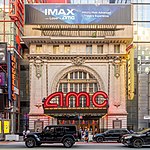The New York Times Building

The New York Times Building is a 52-story skyscraper at 620 Eighth Avenue, between 40th and 41st Streets near Times Square, on the west side of Midtown Manhattan in New York City. Its chief tenant is the New York Times Company, publisher of The New York Times. The building is 1,046 ft (318.8 m) tall to its pinnacle, with a roof height of 748 ft (228 m). Designed by Renzo Piano and Fox & Fowle, the building was developed by the New York Times Company, Forest City Ratner, and ING Real Estate. The interiors are divided into separate ownership units, with the Times Company operating the lower office floors and Brookfield Properties operating the upper floors. As of 2023, the New York Times Building is tied with the Chrysler Building as the twelfth-tallest building in the city. The building is cruciform in plan and has a steel-framed superstructure with a braced mechanical core. It consists of the office tower on the west side of the land lot as well as four-story podium on the east side. Its facade is largely composed of a glass curtain wall, in front of which are ceramic rods that deflect heat and glare. The steel framing and bracing is exposed at the four corner "notches" of the building. The New York Times Building is designed as a green building. The lower stories have a lobby, retail space, and the Times newsroom surrounding an enclosed garden. The other stories are used as office space. During the 1980s and 1990s, the city and state governments of New York proposed a merchandise mart for the site as part of a wide-ranging redevelopment of Times Square. In 1999, the New York Times Company offered to develop its new headquarters on the mart's site. Piano and Fox & Fowle were selected following an architectural design competition, and the land was acquired in 2003 following disputes with existing landowners. The building was completed in 2007 for over $1 billion. The Times Company's space was operated by W. P. Carey from 2009 to 2019; meanwhile, Forest City bought out ING's interest and was then acquired by Brookfield Properties in 2018.
Excerpt from the Wikipedia article The New York Times Building (License: CC BY-SA 3.0, Authors, Images).The New York Times Building
8th Avenue, New York Manhattan
Geographical coordinates (GPS) Address External links Nearby Places Show on map
Geographical coordinates (GPS)
| Latitude | Longitude |
|---|---|
| N 40.756111111111 ° | E -73.99 ° |
Address
The New York Times Building
8th Avenue 620
10018 New York, Manhattan
New York, United States
Open on Google Maps






